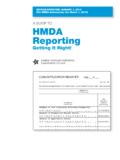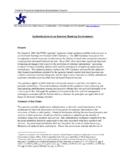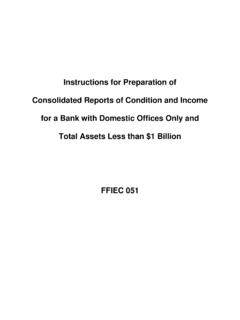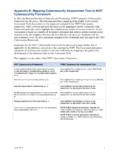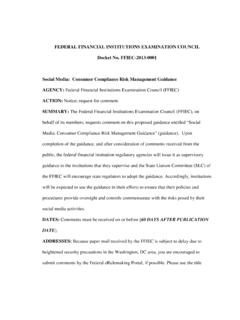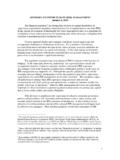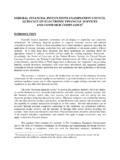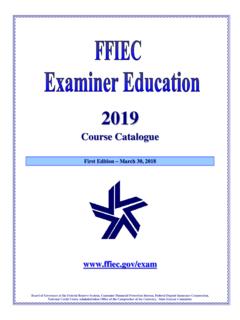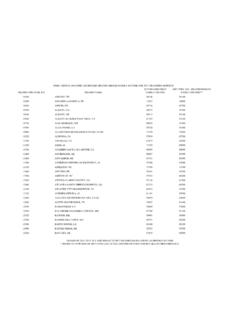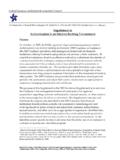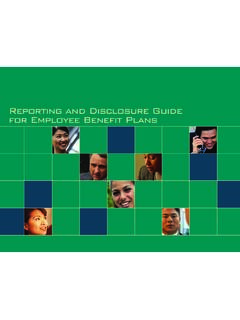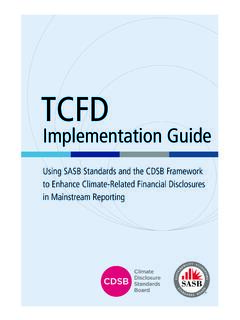Transcription of CRA Guide to Data Reporting and Collection
1 A Guide toCRA Data Collectionand ReportingFederal Financial InstitutionsExamination CouncilJanuary 2001A Guide to CRA Data Collection and Reporting2 This user s Guide was prepared byCRA/HMDA SystemsInformation TechnologyBoard of Governors of the Federal Reserve Systemfor theFederal Financial InstitutionsExamination CouncilA Guide to CRA Data Collection and Reporting3 ContentsForeword4 Executive Summary: Compliance Responsibilities5 Purpose of CRA 5 Who Must Report 5 When to Report 5 Reporting Requirements 6 File Specifications and Edit Validations 6 Collecting the Data8 Composite Loan Data 8 Other Loan Data 14 Consumer Loans 14 Reporting the Data16 Reporting Tools 16 Internet Resources 19 Data Automation Cycle 19 Public Availability of Data 22 Glossary23 Appendix A Regulation BB: Community Reinvestment26 Appendix B Schedule RC-C, Part to Small Businesses and Small Farms46 General Instructions 46 Loans to Small Businesses 49 Agricultural Loans to Small Farms 52 Examples of Reporting in Schedule RC-C, Part II 54 Appendix C Thrift Financial Report Instruction Manual and Form60 Loans to Small Businesses and Small Farms 60 Appendix D Bureau of the Census Regional Offices64A Guide to CRA Data Collection and Reporting4 ForewordIn response to numerousrequests and inquiries, theFederal Financial InstitutionsExamination Council (FFIEC)has developed this Guide forCommunity Reinvestment Act(CRA) data reporters.
2 Datacollection, maintenance, andreporting are importantaspects of large-institutionevaluations under CRA. Thisguide can be used as aresource when collecting andmaintaining data, creating asubmission, and postinglending data in the CRA publicfile. It is designed to reduceburden on the approximately2,000 financial institutionssubject to the reportingrequirements of the of this Guide should beaware of its limitations. Itrelates only to the Collection ,maintenance, and Reporting ofsmall-business and small-farmloan data and to the Collection ,maintenance, and Reporting (as applicable) of other loandata (except data on homemortgage loans) that may beconsidered during CRAevaluations. Although thisguide addresses many issuesrelating to these matters, newissues arise often; they shouldbe directed to the CRAA ssistance Line at (202) 872-7584 or of this Guide is not asubstitute for familiarity withthe CRA regulations and theinteragency questions andanswers (Qs&As) that inter-pret those regulations.
3 Theregulations and Qs&As maybe revised from time to time,and you should consult themto determine whether thisedition of the Guide reflectsthe most recent are available on theFFIEC s Internet site Guide to CRA Data Collection and Reporting5 ExecutiveSummary:ComplianceResponsibilit iesPurpose of CRAThe Community Reinvestment Act of1977 (CRA) is implemented byregulations of the Office of theComptroller of the Currency (OCC),the Board of Governors of theFederal Reserve System (Board),the Federal Deposit InsuranceCorporation (FDIC), and the Office ofThrift Supervision (OTS)(collectively, the agencies) in 12 CFR parts 25, 228, 345, and CRA regulations require thatinformation on business, farm, andcommunity development lending bylarge insured depository institutionsbe made available to the directs the agencies toencourage insured depositoryinstitutions to help meet the creditneeds of the communities in whichthey are chartered.
4 CRA does notprohibit any activity, nor is it intendedto encourage unsafe or unsoundpractices or the allocation of requires that each insureddepository institution s record inhelping to meet the credit needs ofits entire community, including low-and moderate-income neighbor-hoods, be assessed record is taken into accountwhen considering an institution sapplications for deposit facilities,including mergers and CRA regulations containdifferent evaluation methods fordifferent types of institutions: thelending, investment, and servicetests for large retail institutions; thecommunity development test forwholesale or limited-purposeinstitutions; the streamlinedperformance standards for smallinstitutions; and the strategic-planoption for institutions with approvedstrategic Consumer Compliance TaskForce of the FFIEC promotesconsistency in the implementation ofthe CRA regulations by periodicallypublishing interagency Qs&As andexamination procedures and byfacilitating uniform data Must ReportAll state member banks, statenonmember banks, national banks,and savings associations that are notsmall or special-purpose institutionsare subject to the data Collection andreporting requirements of the the purpose of collecting andreporting small business and small-farm loan data, a small institution is abank or thrift that, as of December 31of either of the prior two calendaryears, had total assets of less than$250 million and was independent oran affiliate of a holding companythat, as of December 31 of either ofthe prior two calendar years.
5 Hadtotal banking and thrift assets of lessthan $1 billion. Institutions that arenot small are considered largeinstitutions (see the glossary,beginning on page 23, fordefinitions).When to ReportData for a given year must besubmitted to the Board, thedesignated processor for all of theagencies, by March 1 of the InstitutionsFollowing are three scenariosdescribing data Collection andExecutive Summary: Compliance ResponsibilitiesA Guide to CRA Data Collection and Reporting6reporting responsibilities for thecalendar year of a merger and forsubsequent OneTwo institutions are exempt fromCRA Collection and reportingrequirements because of asset institutions merge. No datacollection is required for the year inwhich the merger takes place,regardless of the resulting assetsize. Data Collection would beginafter two consecutive years in whichthe combined institution had year-end assets of at least $250 million orwas part of a holding company thathad year-end banking and thriftassets of at least $1 TwoInstitution A, an institution requiredto collect and report data, andInstitution B, an exempt institution,merge.
6 Institution A is the survivinginstitution. For the year of themerger, data Collection is requiredfor Institution A s transactions. Datacollection is optional for thetransactions of the previouslyexempt institution. For the followingyear, all transactions of the survivinginstitution must be collected ThreeTwo institutions, each of which isrequired to collect and report thedata, merge. Data Collection isrequired for the entire year of themerger and for subsequent years, solong as the surviving institution is notexempt. The surviving institutionmay file either a consolidatedsubmission or separate submissionsfor the year of the merger but mustfile a consolidated report forsubsequent No Small-Businessor Small-Farm LoansAn institution that has not purchasedor originated any small-business orsmall-farm loans during the reportingperiod would not submit thecomposite loan records for small-business or small-farm , all institutions subject todata Reporting requirements mustsubmit the information discussedbelow under ReportingRequirements.
7 Lenders Covered by HomeMortgage Disclosure ActIf an institution is not required tocollect home mortgage loan data bythe Home Mortgage Disclosure Act(HMDA), it need not collect homemortgage loan data under the will sample an institu-tion s home mortgage loans toevaluate its home mortgage an institution wants to ensure thatexaminers consider all of its homemortgage loans, it may collect andmaintain data on these , extension andconsolidation agreements (MECAs)are transactions in which aninstitution obtains loans fromanother institution without actuallypurchasing or refinancing the some states, MECAs, which arenot considered loan refinancingsbecause the existing loanobligations are not satisfied andreplaced, are common. Althoughthese transactions are notconsidered to be purchases orrefinancings, as those terms havebeen interpreted under CRA, theydo achieve the same results.
8 Aninstitution may present informationabout its MECA activities toexaminers for consideration underthe lending test as other loan data. ReportingRequirementsAt a minimum, institutions mustsubmit, in electronic format: a transmittal sheet, a definition of its assessmentarea(s), a record of its communitydevelopment (CD) loans. (If aninstitution does not have CD loansto report, the record should be sentwith 0 in the CD loan compositedata fields); and information on small-business andsmall-farm loans, if applicableCRA data are aggregated on thecensus tract level, and each tractrepresents one record in an entiredata submission. For example: Six different small-business loansmade in the same census tractwould count as one compositerecord. Six different small-farm loans,three in one census tract and threein another, would count as twocomposite Specificationsand Edit ValidationsThe FFIEC makes available freeCRA data preparation software toany institution that wishes to use software includes some basicanalytical reports regarding aninstitution s data.
9 To obtain a copy ofthe latest version of the software,contact the CRA Assistance Line at(202) an institution finds that theFFIEC s software does not meet itsneeds, it may create a datasubmission using the FileSpecifications and Edit ValidationRules that have been set forth toExecutive Summary: Compliance ResponsibilitiesA Guide to CRA Data Collection and Reporting7assist with electronic datasubmissions. For information aboutspecific electronic formatting proce-dures, contact the CRA AssistanceLine at (202) 872-7584 or click on How to File at SpecificationsInstitutions that develop their ownprograms must follow the preciseformat laid out in the CRA FileSpecifications. This file formatshould be incorporated into anautomated system to ensure anerror-free data Validation RulesWhen an institution chooses tocreate an electronic datasubmission, it must edit its datausing the CRA Edit Validation rules are designed to ensuredata integrity and to prevent edit validations are divided intothree edit types: syntactical, validity,and quality.
10 Each type correspondsto errors of a different degree ofseverity, and each must bethoroughly understood to ensure thatthe data are accurate and (S) Records that contain errors that may prevent themfrom being uploaded to the FFIEC database. These errors range fromincorrect activity years to duplicate property locations, which indicate thatthe property combination for that record identifier was used more thanonce. These records will not be reflected in your disclosure statementuntil the appropriate corrections have been (V) Records containing incorrect information. The mostcommon validity errors are incorrect census tract/BNA numbers. Theserecords will not be reflected in your disclosure statement until theappropriate corrections have been (Q) Loan information that, while it may pass all syntactical andvalidity edits, is nevertheless statistically unusual and is subject to furtherinvestigation or review to confirm correctness.
